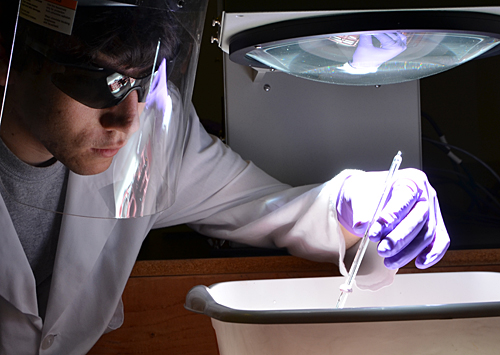You are here
So cool, I wear sunglasses

When you perform research with a device that mimics the sun, you better be wearing sunglasses. Undergraduate intern Nathan Hinkle understands that because he uses a solar simulator to determine the rate at which components of crude oil are degraded by sunlight.
Oil spills, such as the 2010 Deepwater Horizon disaster, release massive amounts of toxic chemicals into the environment. Surface clean-up cannot recover all of the oil, and a large amount of the toxins dissolve and disperse into the water column, making them impossible to visually trace. Yet, oil naturally degrades by sunlight and aquatic microorganisms.
To better understand how sunlight and bacteria degrade oil, the Aquatic Biogeochemistry and Plankton Ecology lab at CMOP, led by Dr. Joseph Needoba and Dr. Tawnya Peterson, is partnering with Wet Labs to develop improved in situ sensors for tracking oil spills. They use artificial seawater with dissolved or dispersed components of crude oil for testing. Those samples are degraded by using a solar simulator that mimics the full-spectrum of sunlight. Throughout the experiment, the samples are run on a spectrofluorometer that measures changing rate of degradation. The results will help determine the rate at which components of the oil are degraded by sunlight.






